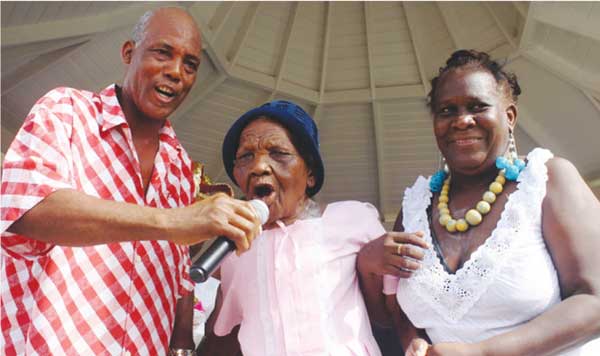The Music

“The song and dance types associated with La Rose and La Marguerite are many. There is much more variation and spontaneity at séances than at the Grande Fete when the significance of the occasion demands more discipline. At a séance one can witness anything from a “Mapa” (Simmons 1963:44; Crowley, 542) to a “Quibishe”, although the former, a kind of “gwan won” is the most popular dance at séances. According to Crowley “Grande Fete dancing is traditionally limited to Quadrilles, Lancers, Belair, and other figure dances, though in recent years there has also been some ballroom type dancing” (542). Simmons lists among the dance types “Quadrille, Lancers, Polka, Muzurka and Schottishe” (1963:45).
As has been stated above, the chantwèl is the central figure in the musical tradition of the twin festival. She (or he) leads the song, with the other members of the group acting as chorus in a call-and-response pattern. Instrumentation includes any combination of violin, banjo, quatro, quitar, shak-shak, baha and drums.
The song of the chantwèl is called a “Belair”. Some Belairs are vibrant and boisterous, galvanizing chantwèl and chorus into vigorous dancing, while others are of “a plaintive and melancholy character” (Simmons 1963:43). Crowley asserts that “:the quavering, piercing tones, and the careful enunciation suggests the singing style of French ‘chanteuses’, while the chorus is sung in the manner of ‘Sankey’ hymns” (p.545). Most are sung in Patwa (St. Lucian French Creole), although there are many new compositions in English.
La Rose and La Marguerite Belairs may be divided into four types: (1) those which laud the beauty and power of the rose, the society and its members, particularly the king and queen; (2) those which sing likewise of the Marguerite, (3) those which poke fun at the Roses and (4) those which poke fun at the Marguerites. The art of outwitting, abusing or teasing (mépwi) members of the rival society is the favourite subject of the Belairs (cf. Crowley 546). Thanks to the musical creativity of Charles Cadet who prepared the music for Roderick Walcott’s two plays on the flower festivals, The Banjo Man (1969) and Chanson Marianne (1974); as well as to the work of Joyce Auguste and Hewanorra Voices, a number of La Rose and La Marguerite songs are well known and quite popular in the wider St Lucian society. However, the grueling task of preservation and popularization of the La Rose and La Marguerite songs, against all odds, have fallen on the back of the myriad chantwèls of extraordinary talent all over the island. Without their passionate love and dogged commitment these traditions would have perished. And among these chantwèls there is none so gifted and loved as the famous Dame Marie Selipha Descartes (Sessenne) of Patience.”
Excerpt from Section II: Origins of the Flower Festivals, pg. 6, THE FLOWER FESTIVALS OF SAINT LUCIA, Second Edition, Hon. Msgr. Patrick A. B. Anthony, PhD, SLC. Published by @FolkResearchCentre & Jubilee Trust Fund, Castries, Saint Lucia, 2009.
Achieving Objectives under B. Cultural Heritage – Preservation and Protection, NATIONAL CULTURAL POLICY
#NationalCulturalPolicy #CulturalHeritage #Preservation #Protection #FlowerFestivalsofSaintLucia #LaWoz #LaRose #LaMagwit #LaMarguerite #CDF #FRC #JubileeTrustFund

